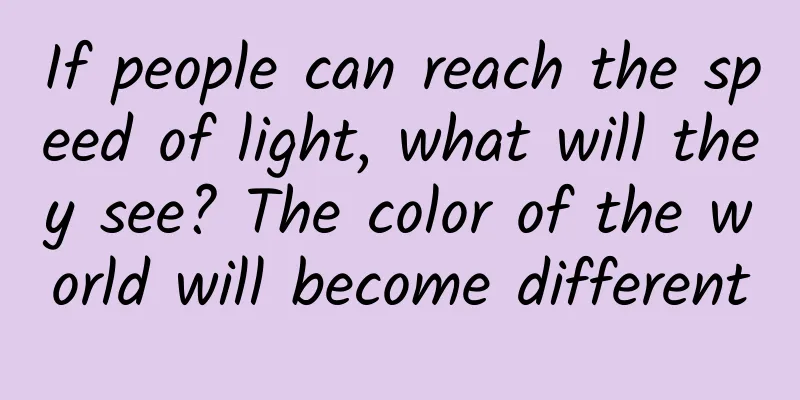If people can reach the speed of light, what will they see? The color of the world will become different

|
Why can we see this colorful world? Because of light. The reason why we can see things is essentially the result of light shining on objects and reflecting into our eyes. For example, we cannot see the situation within the event horizon of a black hole because the escape velocity exceeds the speed of light within the event horizon of a black hole. The light that enters the event horizon of a black hole has no way to get out again, so it naturally becomes an invisible world. Light is composed of photons, and photons, as basic particles, are objectively existing substances. Because they have no rest mass, light has the fastest speed in the universe, which is 299,792,458 meters per second. Any object with rest mass cannot reach the speed of light. Although we have no way to catch up with light in the real world, there is nothing that can stop us in the world of thought, so a very interesting question arises. If we could move at the same speed as light, how would we see the world differently? We live in a macroscopic low-speed world. According to our common sense, if we move forward at the speed of light, the world we see will not change at all, because moving forward at the speed of light only makes the light from the front enter our eyes faster. When we move backward at the speed of light, the situation is completely different. The light from the front can never catch up with us, so we can't see anything. Is this really the case? No, it sounds reasonable, but it is a conclusion drawn entirely based on common sense in a macroscopic low-speed environment. In fact, it is not like this. When it comes to the speed of movement, we always have to choose a reference system, so what is the reference system of the speed of light? We kick a football forward and the ball flies forward at a speed of 5 meters per second. The "5 meters per second" here is obviously based on us who are kicking the ball as the reference system. So does light also use the light source as a reference system? It seems that this should be the case, but in fact it is not. There are many binary star systems in the universe. They are composed of two luminous stars orbiting each other. From our perspective, one of the two stars orbiting each other is always moving away from us, while the other is rushing towards us. If the speed of light is based on the light source as a reference system, then the speed at which the light of the two stars in the binary star system reaches our eyes will continue to change, so from our perspective, the orbit of the binary star system should also be constantly deforming, but the actual situation is that these orbits are very stable and there is no change. Therefore, light is not based on the light source as a reference system. Einstein made a bold assumption that the speed of light is not relative to a single reference system. Relative to any reference system, the speed of light is 299792458 meters per second and is constant. Therefore, even if we reach the speed of light, the speed of light relative to us is still 299792458 meters per second. Whether we are moving forward or backward, what we see will not change, and there will not be a situation where everything in front of us is completely dark due to high-speed backward movement. However, if people can really move at the speed of light, the world they see will not change at all, at least the colors will be different. Most people have heard a train whistle, and perhaps you have noticed that when the distance is the same, the whistle of a train coming towards us is louder, while the whistle of a train heading away is deeper. Why is this? Sound is transmitted in the form of sound waves. Since it is a wave, it has three properties, namely wave speed, wavelength and frequency. When the train is coming towards us, the sound waves generated by the whistle will be squeezed by the moving train, so the wavelength becomes shorter, but the wave speed of the sound wave remains unchanged, so the wavelength becomes shorter and the frequency increases, which makes the whistle sound change when it enters our ears. When the train is moving away from us, the situation is just the opposite. This is the internal reason why the whistle sounds different when the train is coming and when it is leaving. This was discovered by Austrian physicist Doppler, so it is also called the Doppler effect. Light has the dual nature of wave and particle, that is, light is both a wave and a particle. Since light is a wave, it naturally follows the Doppler effect. So when we move at a speed close to the speed of light, the wavelength of light will be compressed. Different wavelengths represent different colors of light. The shorter the wavelength, the closer the light is to purple, so the world in front of us will be purple. This phenomenon is called "blue shift". Conversely, if we move backward at a speed close to the speed of light, the wavelength of light will be stretched. The longer the wavelength, the closer the light is to red. So the world in front of us will be red. This phenomenon is called "red shift". Of course, this means that our speed is still within a controllable range. If our moving speed can be increased infinitely, then in the end we may really not be able to see anything, because the wavelength is too short or too long, it will exceed the range of visible light. For more information, please follow the official account: sunmonarch |
>>: Ear piercing causes intracranial infection. Can a small ear piercing cause such a big harm?
Recommend
Do drugs have "left and right hands"? The mysterious mystery of chirality
The internationally renowned journal "Journa...
How do free tool apps acquire users?
The way for free tools to acquire users must be a ...
After studying 10 big Douyin accounts, I found 8 Douyin promotion routines
Brother Xian has been feeling rather depressed la...
iOS componentization exploration: creation of private libraries
iOS componentization is basically based on cocoap...
Alipay launches “Pay Later” feature: buy first and pay the next day
[[347332]] Recently, Alipay quietly launched the ...
Illustrated explanation of the hand seals of the Taoist secret technique "Nine-Character Mantra"!
The Nine-Character Mantra is a secret technique o...
Smart TVs have entered the deep waters. How can we make useless functions more practical?
With the impact of the Internet on the traditiona...
WeChat’s new killer feature—“Nearby Businesses”
When the WeChat Nearby People app first appeared,...
Snow White is real, and the magic mirror is really weird
Leviathan Press: According to the research of pha...
Faced with Tesla’s ever-lower prices, where will China’s new energy vehicle companies go?
From watching the fire from the other side to clo...
A profound question: What is equality?
Before we really get into mathematics, our parent...
7 techniques to explain QQ group marketing and WeChat group marketing!
Groups are an Internet product with a relatively ...
APP operation: How to quickly acquire and retain users?
Nowadays, the demographic dividend is getting sma...
How to build a user portrait system? Just read this one article!
Only by deeply understanding the characteristics ...
In the competition for special drugs for COVID-19, which “players” stand out?
The new coronavirus pandemic is not over yet. In ...









